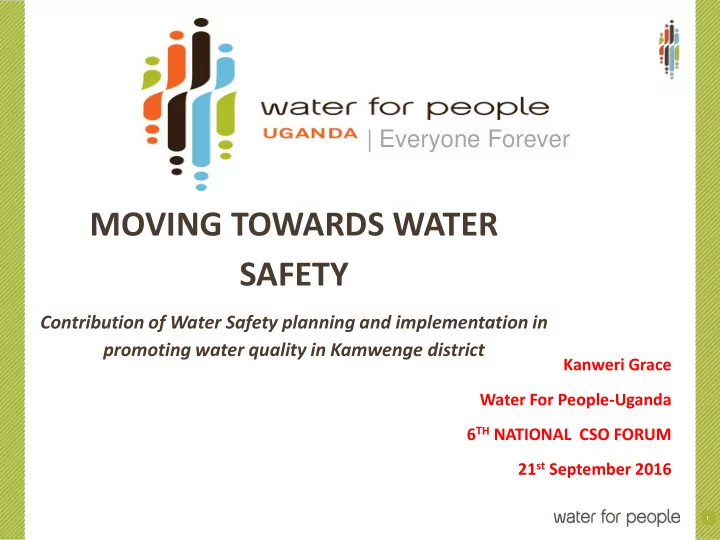

| Everyone Forever MOVING TOWARDS WATER SAFETY Contribution of Water Safety planning and implementation in promoting water quality in Kamwenge district Kanweri Grace Water For People-Uganda 6 TH NATIONAL CSO FORUM 21 st September 2016 1
OUTLINE 1. About Water For People 2. Background to Water Safety Planning 3. Water quality testing results 4. Scope of the intervention 5. Before and after WSP 6. Lessons Learnt 7. Challenges and recommendations 2
UNIQUE PROGRAMMING Sanitation as a Business Water For People-Uganda promotes a market-based approach to sanitation by supporting sanitation businesses and testing different sanitation solutions to increase demand and supply of sanitation services . Water as a Business Water For People – Uganda works together with the private sector to promote water businesses that will charge fees to manage and maintain water systems, ensuring water flows in Kamwenge . EF Replication Water For People is known locally and nationally as an NGO with a unique approach to advancing water and sanitation in Uganda by focusing on access (Everyone) and sustainability (Forever).
Background to Water Safety planning • Contributes to SDG 6 Aimed at improving water quality by reducing pollution, eliminating dumping and minimizing release of hazardous materials in water. Target 6b encourages strengthening the participation of local communities in improving water management . 5
WATER QUALITY TESTING • Comprehensive water quality analysis Microbiological analysis: Coliform Forming Units (CFU/ 100ml) Physical analysis: Electrical conductivity, PH, Turbidity. Chemical analysis: Iron 6
Water Quality Testing Results : CFU/100ML 42 sources that had more than 25 CFU/100ml were selected to pilot the water safety planning intervention Classification of Sources by the number of CFU/100ml 12% 0 36% 12% > 0 <= 25 > 25 <= 50 > 50 40% Presentation Outline 7
Water Quality Testing Results per technology • A sample of 321 water points were surveyed/ tested. • Only 36% of the tested sources were found to have 0CFU/100ml. Proportion of Source Types in Conformity with WHO Drinking Water Standards (0CFU/100ml) Unprotected Sources 6% Rain Water Catchment 2% Boreholes 24% Shallow Wells 2% Public Stand Posts Protected 47% Spring 19% Presentation Outline 8
NATURE AND SCOPE OF THE INTERVENTION 1. Dissemination of Water Quality results 2. Training at Sub county Level 3. WSP Team Development 9
NATURE AND SCOPE OF THE INTERVENTION Water Source Assessment for risks Action planning and implementation Presentation Outline 10
WSP- IMPLEMENTATION Presentation Outline 11
SUB SEQUENT WATER QUALITY MONITORING 12
COMPARISON OF BEFORE & AFTER SITUATION SN SC Community Name of the point Type of Point CFU/100ml_ CFU/100ml_ Name March 2016 July 2016 (before (after WSP) WSP) 4 Bihanga Kabingo|Kitash Bifakubaho shallow Protected Hand 50 0 enya well pump Buhanda Bujumiro|Kengy Kengeya central Protected Hand 65 9 5 eya B shallow well pump 6 Buhanda Kakasi|Iryangab Iryangabi 111 water water spring 50 0 i 1 spring Buhanda Kakasi|Nsinda Kyabwayo spring protected spring 49 0 7 1 8 Kamwenge Ganyenda Gayitano Protected 40 80 Shallow Well shallow well 13
Most common risks • latrines upstream of the • Lack of fences around the source within 30m from the water sources . water point. • The loose pedestals of • pollutants around the water the hand pumps at the source eg animal excreta, base. washing. • Lack of runoff diversion channels. • stagnant water on the platforms, drainage • Cracked slabs and channels of hand pumps inspection covers. and protected springs. 14
COSTING FOR WATER SAFETY PLANNING Activity Cost District and sub county level training 1,200,000 UGX ($357) Community training at water source level 850,000 UGX ($250) Water quality monitoring/ quarter 100,000UGX ($30) Presentation Outline 15
TEAMS/PARTICIPANTS INVOLVED • District: DHI, County Health Inspectors, Water Officer and CDO • Sub county : CDO, Health Assistant, HPM, Sub County Chief, LC3 Chairperson • Parish - Area parish chief LC2 Chairperson • Village/water source: Land Owner, Caretaker of Source, Village LC1 and Water Source Chairpersons 16
LESSONS LEARNT • Water quality testing is key to getting communities appreciate water safety planning interventions • Identification water safety issues through a participatory process is important for success • having the land owner on the team the WSP team is very key; makes possible negotiation for land • Having a team with complementary skills and strengths is important • None-Payment for water has an effect on WSP • For more resilient cases, chlorination is preffered. 17
CHALLENGES • Some of the land owners are not willing to give the community more land. • Relocating toilets within the Minimum Safe Distance (MSD) of the water source (10- 15 meters) is a challenge. 18
Recommend
More recommend